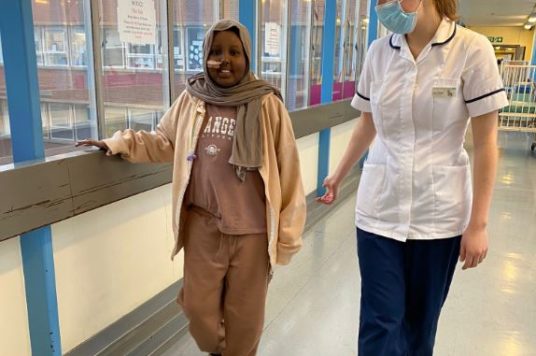St George’s helps Leukaemia patient walk again for 14th birthday
A teenage cancer patient has relearned how to walk after three years of chemotherapy and stem cell transplants left her too weak to walk.
Ismahan Ahmed was diagnosed with acute myeloid Leukaemia when she was 11 years old in 2019 after experiencing daily sickness and fainting, weight loss, anaemia and dehydration.
She said: “I was living in Kenya at the time and the doctors weren’t sure what was wrong with me, but when we moved back to London, my mum took me to St George’s and just a few hours and multiple tests later I found out I had acute myeloid Leukaemia”. Ismahan was on the same day transferred to St George’s paediatric intensive care unit, one that cares for over 800 critically ill children every year.
Ismahan needed three rounds of chemotherapy to treat the blood and bone marrow cancer within the paediatric services department at St George’s, which treats over 130,000 Paediatric patients a year and is rated Outstanding by the CQC. Ismahan’s chemotherapy was followed by a stem cell transplant at the Royal Marsden.
She said: “I was lucky that my brother was a 100% match and was my stem cell donor. Everything was a success, until February 2021, and after my routine blood work my doctor noticed some bad cells showing that I had relapsed. I was devastated, my life was just getting better, now this.”
Ismahan’s relapse meant that she needed further rounds of chemotherapy at St George’s and another stem cell transplant at the Royal Marsden. While they were successful in treating the cancer, they left her with stress induced injuries and weakness meaning she was unable to walk.
She decided to set herself the target to learn to walk again by the time she turned 14 years old at the end of January 2022, which she managed to do with the support of the physio team at St George’s.
She said: “It’s been such a difficult three years, particularly being in hospital during the pandemic, but having this goal and timeline to focus on has helped me stay positive and I’m so happy to achieve my goal of learning how to walk again.”
She added: “I’m so thankful to the entire clinical team, but particularly the physio team who have really helped me overcome the weakness I was experiencing and help build my confidence to succeed.”
Isobel Highett, paediatric physiotherapist at St George’s, said: “Seeing the difference in Ismahan’s confidence levels over the last few months has been amazing. She has progressed so much from being mainly in bed and finding it difficult to walk around her hospital room, to now being able to walk up and down stairs and do some exercises.”
Ismahan remains positive and will soon be able to leave hospital and continue her recovery from the comfort of her home.
She said: “Think positive and be patient as you don’t know what life will bring. I hope 2022 will be better. Keep smiling!”
Dr Sijo Francis, Clinical Director for Children’s Services at St George’s, said: “It’s humbling to see the resilience of children like Ismahan and I’m very proud of the comprehensive children’s team at St George’s whose multidisciplinary and collaborative approach have helped Ismahan throughout her journey.”
Ms Sophie Scott, Head of Children’s Therapies, said: “Ismahan has had a challenging few years, but I credit her recovery to her incredible strength and resilience which is essential for therapists to be able to achieve such remarkable results particularly alongside such complex and ground-breaking treatments.”
ENDS
Notes to editors
St George’s University Hospitals NHS Foundation Trust is the largest healthcare provider, major teaching hospital and tertiary centre for south west London, Surrey and beyond – and one of the largest healthcare providers in the UK – serving a population of 3.5 million.
Its main site, St George’s Hospital – one of the country’s principal teaching hospitals – is shared with St George’s, University of London, which trains medical students and carries out advanced medical research.
St George’s is one of 11 adult and children major trauma centres in the UK, one of eight hyper acute stroke units and one of the biggest and busiest of the eight heart attack centres in London.
It is also an accredited centre of excellence for trauma, neurology, cardiology, cancer and blood pressure services and is the national centre for family HIV care and bone marrow transplantation for non-cancer diseases.
St George’s children’s services are rated outstanding by the CQC.
St George’s is the only hospital site in London where children with cancer can receive oncology surgery, PICU and neurosurgery as well as oncology care all on the same site with the other specialties that are required as well.
Of the 16 specialisms in paediatrics, St George’s offers all but three.
Every year St George’s treats over 130,000 children and deliver 5000 babies.


